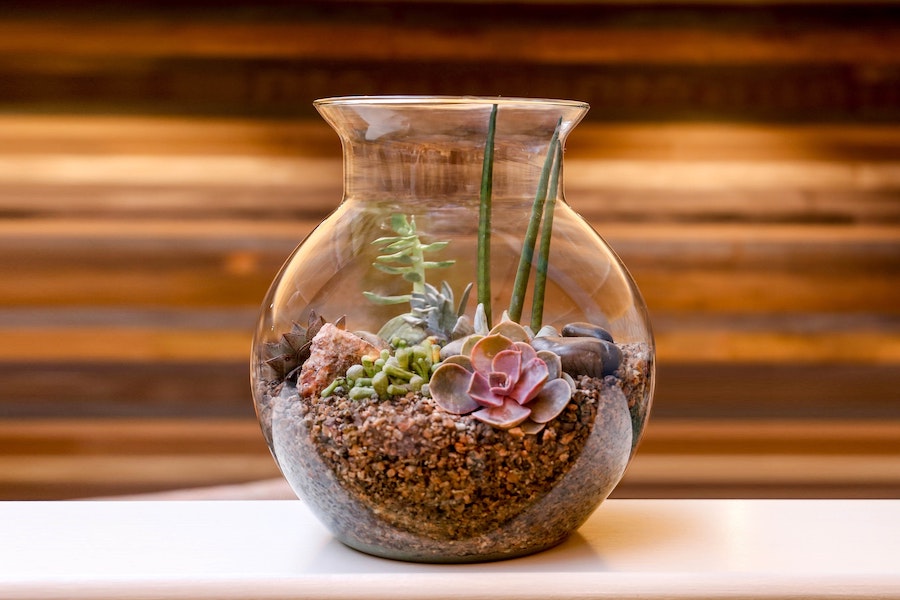Want to create a bottle garden full of luscious houseplants? Here’s how to do it
There’s a huge buzz around houseplants at the moment, from cacti and air plants, to all manner of low-maintenance specimens.
Creating your own bottle garden, containing a variety of easy-care houseplants, can provide an eye-catching centrepiece to a table or sideboard, with the least amount of fuss and mess.
We attended a Squire’s Garden Centres masterclass to find out how to do it.
1. What you’ll need

Choose a glass bottle with a wide neck to make planting easy
Start with a glass bottle with a wide base – to allow maximum space for your plants – and a wide opening you can easily get your hands into to plant your mini indoor garden; it’ll provide the plants with good ventilation, too.

Use cactus and succulent potting mix
You’ll need a small bag of potting grit to allow good drainage and help avoid waterlogging, and a small bag of cactus and succulent potting mix.

Succulents are a good bet
Of course, plants are key. Use denominations of odd numbers, which are easier on the eye – we used five. Cacti and succulents are the ideal choices. You can use upright sansevieria to create height, while aloe vera, cacti, echeveria, sempervivum and Crassula ovata (money plant) are all suitable to grow in a bottle.
2. Create good drainage

A layer of grit creates the necessary drainage
Use a small empty flowerpot to transfer potting grit into the base of the bottle. It needs to be around 2in (6cm) deep to provide the drainage your plants will need.
Press and smooth the grit so there are no air pockets, then make a slight dip in the centre of the grit, into which you’ll pour the potting mix. That way, the compost won’t touch the glass and you will be left with just the grit and the plants visible from the side.
3. Pour in the potting mix

Create a circle of potting mix within the grit
This is made from compost ideal for cacti and succulents. Use the small flowerpot to transfer the compost into the bottle, pouring it carefully into the dip in the centre so you don’t get potting compost on the glass. Create a small mound – the plants won’t need much root depth.
4. Position your plants

Sansevieria can be placed behind low-growing rosettes of succulents
Your bottle garden is likely to have a front and back, so use taller plants like upright sansevieria at the back and low-growing plants such as sempervivum at the front. You shouldn’t need to water them before planting. If they are dry, they are easier to pot.
5. Don’t overfill your bottle
Give the plants plenty of room to allow as much air circulation as possible.
Once you have planted them in the compost, firm them in so there are no big air pockets and the soil is even. Don’t plant them too deeply as you are going to finish off the bottle with another layer of grit and you don’t want the plants to disappear.
6. Finish off with another layer of grit
This last stage should be done carefully, so you don’t damage your plants. Use a small, clean paintbrush to dust grit off the leaves.
Alternatively, cut out small circles of fleece or scrap material to lightly cover and protect the surface of your plants, particularly the leafy rosette kinds, before you add the final layer of grit to hide the compost completely. Remove the fleece once the grit has been added.
7. Personalise your bottle
View this post on Instagram#madewithlove #madewithpassion #madebyme #echeveria #succulents #glassterrarium #флорариум
Add small stones, flint or slate, which may match the décor of your house, or even add elements of fun, such as Lego characters or shells.
8. Water sparingly

Try not to get water on the leaves
The plants in bottle gardens tend to be slow-growing and should last for a few years before they need repotting.
Water lightly once or twice a month in the winter, using a small watering can with a narrow mouth so you can direct the water on to the compost. Try not to get water on the leaves, as this can lead to rotting. If you see water pooling at the bottom of the bottle, you’ve gone too far.
In winter, they will need less watering than in summer. Do the finger test – if you put your finger in the compost and it comes out bone dry and clean, you may need to add a little water.
9. Give them light
Succulents and other bottle garden plants need plenty of light, but preferably not direct sunlight, which can scorch the leaves. Don’t put them close to radiators.
10. Remove dead leaves
If dead leaves appear on rosettes and other plants, remove them to stop the plants rotting, and if it’s clear they are struggling, move them to a lighter, drier area. They don’t like too much humidity so avoid putting a bottle garden in your bathroom. Rotten leaves indicate too much moisture.
Remember, most people kill their houseplants with kindness and these bottle garden beauties need very little care.
Squire’s Garden Centres are holding bottle garden planting masterclasses with succulents on March 15, priced £25. For details and to book online, visit squiresgardencentres.co.uk.
The Press Association
Latest posts by The Press Association (see all)
- What you need to know about weight loss jabs and how to make them work effectively - April 25, 2025
- Is our skin more susceptible to sun damage as we age? - April 25, 2025
- Special stamps to mark 80th anniversary of VE Day - April 24, 2025
- Test your knowledge with our penguin-themed quiz - April 24, 2025
- Prince Louis shows off missing front teeth in new photo to mark seventh birthday - April 23, 2025



















